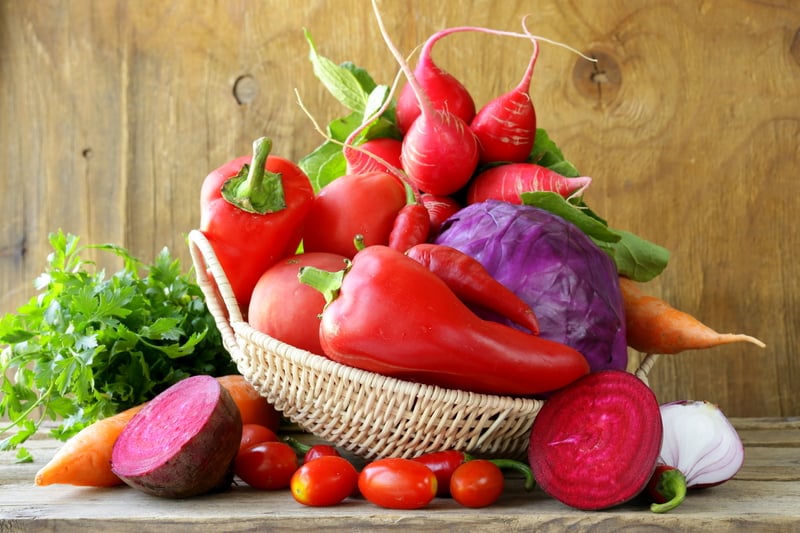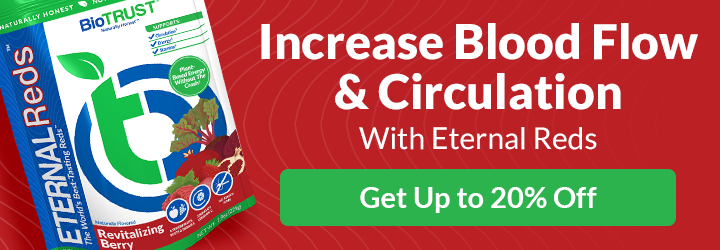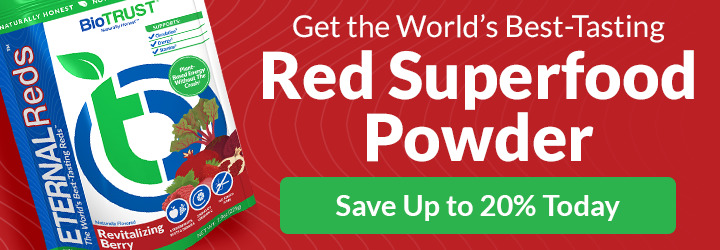10 Red Vegetables and Fruits You Need in Your Diet

While green leafy vegetables seem to get much of the praise when it comes to the healthiest vegetables, there’s another group that too often gets overlooked. And that’s despite dressing their best and looking beautiful and vibrant. Yes, we’re talking about red vegetables. This colorful crew has some surprising benefits, like helping improve blood flow and lowering the risk of diseases from diabetes to osteoporosis to heart disease and more.
Red vegetables have these many benefits due in part to the phytonutrients found in these foods, which also provide their beautiful hue. For example, the antioxidants lycopene and anthocyanin, along with other vitamins and minerals, have been shown to help support a strong immune system and fight illness. The deeper and more colorful the red vegetable, the higher concentration of these key phytonutrients.
Lycopene, for example, has been shown to help reduce the risk of heart disease, promote eye health, fight infection, and more. Anthocyanins, on the other hand, have been shown to help support the liver, improve eyesight, decrease elevated blood pressure, and help the body maintain healthy levels of inflammation.
Most of us, unfortunately, don’t get enough vegetables in general. And that’s especially true of red vegetables. According to the Natural Cancer Institute, up to 95% of adults don’t eat enough of these colorful foods.
10 Red Vegetables and Fruits to Add to Your Diet
1. Beets
Beets contain loads of antioxidants as well as fiber, folate, nitrates, potassium, and vitamin C. Recent research suggests these earthy bulbs may even help lower blood pressure, improve blood flow, decrease inflammation, and boost endurance. 1, 2 Beets also appear to have beneficial effects on the digestive system by helping food move through the system due to their high fiber content. This nutrient-rich vegetable may also help the body get rid of excess cholesterol and help protect the liver. 3, 4
To get more beets into your diet, try roasting them or sauteing them with some greens, quickly steaming them, or even enjoying them raw. You can also drink beet juice, but it’s best to mix beet juice (or beet juice powder) with other red vegetables and fruits like pomegranate, berries, and red apple to increase the nutrient variety and flavor.
2. Berries
Red berries like strawberries, raspberries, gooseberries, and cranberries as well as purple berries like blackberries and boysenberries are all rich sources of antioxidants, including vitamins C, E, beta-carotene, and anthocyanins. They’re also high in fiber. Together, these nutrients work to support heart health, improve both fat and glucose metabolism, and protect the brain and cognitive functioning. 5 – 7
3. Tomatoes
Rich in the potent antioxidant lycopene as well as vitamin C, potassium, and loads of flavor, tomatoes are a perfect addition to nearly any meal. 8 – 11 Plus, according to the National Institutes of Health (NIH), they provide up to 85% of the lutein in the diet. 12 They go well with pasta or zoodles, in fresh salads, in chili, in soups, and so much more. Just make sure you cook or eat them with a bit of oil, so it’s easier for the body to absorb the nutrients in this popular red vegetable.
4. Red or Purple Cabbage
Red or purple cabbage doesn’t just look great in salads, it’s also loaded with anthocyanins, vitamin C, and vitamin A, vitamin B6, potassium, manganese, and of course, fiber. 13 It also shares the benefits of other cruciferous vegetables like broccoli, Brussels sprouts, and kale. Raw red cabbage provides a delicious crunch to cold salads and warm dishes, but you can also steam it or ferment it.
You may also want to consider radicchio, which is similar to red cabbage, though it tends to taste a bit more bitter. It’s a good source of zinc, copper, and vitamin K and can be eaten raw, cooked, or grilled.
5. Red Bell Peppers
If you’re looking to add more vitamin C into your diet, look no further than red bell peppers. These veggies are not only one of the highest sources of C (with triple the daily requirements), they are also rich in vitamins A (your daily requirements in one serving), B6, folate, and vitamin E, as well as antioxidants like lycopene and fiber. They’re also low in calories with only 30 per serving. These nutrients are all needed to help support immunity, promote radiant skin, prevent disease, and protect eyesight. 14 Plus, red peppers are delicious when raw as well as cooked and easily fit into a variety of dishes.
6. Red Chili Peppers
Some like it sweet, and some like it hot. If you prefer your meals to have a bit more kick, then red chili peppers not only heat things up, they also are rich in nutrients like capsicum. This compound has been shown in research to help alleviate pain and inflammation and even to help fight disease. Plus, peppers of any kind are high in vitamins C and A, along with magnesium and copper. 15 Add some to your next batch of chili, salad, and more.
RELATED: Collagen Doesn’t Work (Unless…)
7. Radishes
Another food that offers a potent punch of flavor in a small package, radishes are part of the cruciferous family. As such, they provide a good amount of vitamin C, folate, and potassium. And they’re very low calorie—with just nine per cup. Yet because they’re such a rich source of fiber and water, they’ll help fill you up to keep you satisfied. 16, 17 Try them either raw or pickled (perhaps in kimchi).
8. Red Apples
Apples are one of the most gut-healthy foods you can find as the polyphenols found in them help balance bacteria in the lower GI tract. Plus, much of the immune system is found in a healthy gut. 18, 19 Red apples are also rich in antioxidants like anthocyanins and flavanols like catechins, epicatechins, procyanidins, and quercetin. Choose apples that are both firm and brightly colored. Apples are great to take with you for an easy snack any time.
9. Red Onions
Yet another food high in antioxidant flavonoids and anthocyanins, red onions may help prevent excess inflammation, support the immune system, and protect against unhealthy microbes. They’re also a good source of the prebiotic fructooligosaccharides to promote a healthy gut and support digestion. Due to their high amounts of free-radical fighting antioxidants (such as onionin A and quercetin), red onions may also help decrease the risk of many diseases. 20
You can easily add red onions to salsas, salads, wraps, and sandwiches or roast, steam, boil, or otherwise cook them to add to a number of different recipes.
10. Pomegranates
The red, crunchy, delightfully flavored fruit seeds (or, more accurately, arils) are having a moment. They just look so good when added to a salad, dessert, or even a glass of water, cocktail, or popsicles. They also have a lot to offer to help support a strong, healthy body. They’re packed with nutrients like fiber, vitamin C, folate, potassium, and loads of antioxidants, including punicalagin, anthocyanins, and hydrolysable tannins. Research has found pomegranates help protect heart health, decrease the risk of disease, control inflammation, and protect muscle. 21 – 26
Of course, there are other red vegetables and fruits that provide a wealth of nutrients. Don’t overlook these options as they also offer similar compounds, including the potent antioxidants that provide their brilliant red color:
- Rhubarb
- Grapes
- Red spinach
- Red leaf lettuce
- Red kidney beans
- Red lentils
- Red potatoes
- Red carrots







